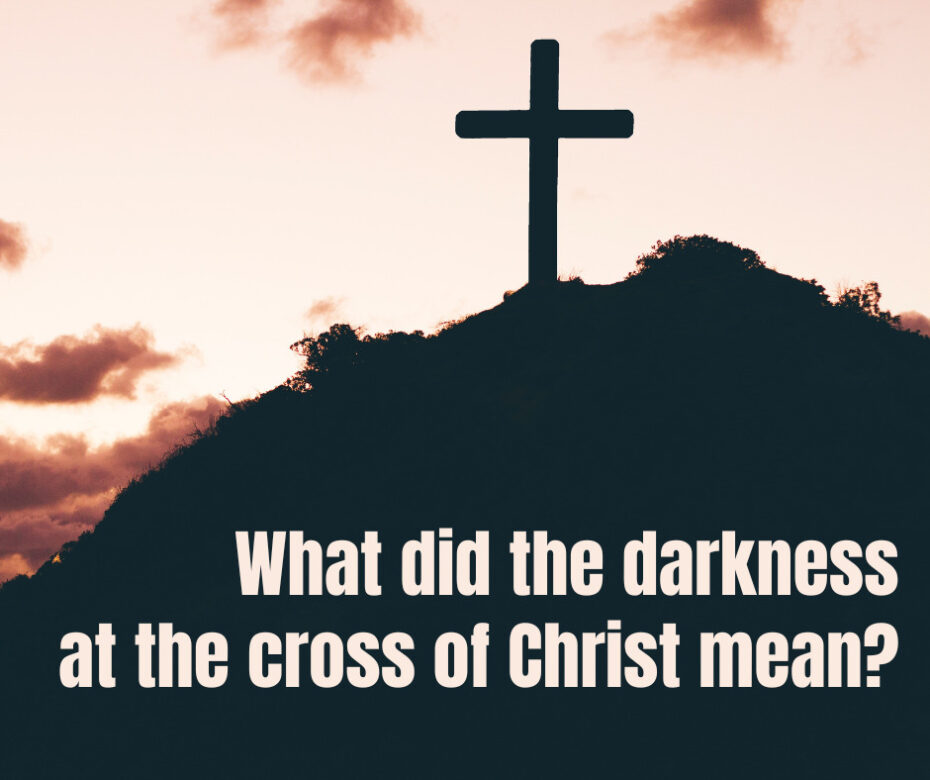In part 2 of this series, I discussed two popular ways of understanding the darkness at the cross of Christ. While there were some truths contained in those views, I think there is a better alternative. This alternative fits the context of Mark 15 better. There are two keys to adopting this view. The first is a proper understanding of Christ’s supposed abandonment by the Father in Mark 15:34. The second is the idea of judgment.
The cry of the Lord in Mark 15:34 comes directly from Ps 22:1. Christ calls out wondering why the Father has forsaken Him. References to this Psalm are found in 15:24 and 15:29-32). Psalm 22:14-17 describes a crucifixion. It should be noted that the Psalm ends with God’s deliverance of the one who cried out in verse 1 (Ps 22:22-25). This looks forward to the resurrection of Christ in Mark 16:1-8. When Christ quotes the first verse of the Psalm, the whole Psalm is in view. The cry is a cry of victory for the Righteous Sufferer on the cross, not of abandonment by God.
Psalm 22:4-5 is particularly important. It speaks of how God had delivered the Jews from Egypt. One of the ways He did that was through the plague of darkness in Egypt (Exod 10:22). It lasted for three days. On the cross, the darkness lasted for three hours. After the plague of darkness, the Egyptians experienced the death of their firstborn sons. On the cross, the firstborn Son of God died. Darkness in Egypt was a sign that God was judging that nation. Here, in the death of Christ, the nation of Israel had rejected their King. All that happened leading up to the cross and all that was happening there cried out for judgment. The darkness in the land was a sign of judgment coming upon them for their sin. This judgment would fall in AD 70.
The Gospel of Mark opens with John the Baptist and then Jesus Himself offering the kingdom of God to that generation of Jews (1:15). However, beginning with their leaders, it is clear that they would reject that offer (3:6, 22; 6:6, 27; 8:31; 9:31; 10:33-34). Because of that rejection and their killing of the King, God would severely judge the nation. This is inherent in John and Jesus’ call for the nation to repent. If they repented, they would be blessed. If they did not, God would discipline the nation.
But the darkness was not only a message of judgment coming upon the nation. It also involved a judgment that involved the lives of the disciples.
When the Lord began His ministry, not only did He offer the kingdom to Israel, He also encountered Satan (Mark 1:12-13). Satan, of course, was the one responsible for bringing sin into the world. Mankind has been enslaved to the power of sin since that time. That sin also meant that every person would die. This was the curse put on man because of sin.
It is clear that on the cross, Christ took on the sin of the world (John 1:29; 2 Cor 5:21). In Luke 22:53, as Christ leaves the Garden of Gethsemane to finish His work He was sent to complete, He refers to that hour as the “power of darkness.” This is almost certainly a reference to Satan. Just as the Lord had faced Satan when He began His ministry, He would face him again at the end of it (cf. Gen 3:15).
In Mark 10:45, the Lord is speaking to the disciples about the cost of following Him in discipleship. He speaks of Himself as a Servant who gives His life as a “ransom.” The word means to pay the price to set someone free from slavery. This points to the cross, when the Lord paid the price to set His people free from slavery to sin.
Just as the darkness on the cross pointed to the judgment that would fall on the nation, the darkness also pointed to Christ’s judgment on sin. The power of darkness had brought the curse to this world. How appropriate it was that when the One who paid the price to release His people from that curse, darkness would fall over the land. He came to undo the darkness and curse (Gal 3:13).
In His resurrection, He would, of course, defeat death. But there is another emphasis here. The book of Mark is about discipleship. If believers were to follow Christ in discipleship, they would need to be released from the power of sin. The resurrection of the Lord shows that the believer can now live righteously because the power of sin has been broken. The believer no longer has to serve it (1 Pet 2:24; Rom 5:8-10). The power of sin, the power of darkness, has been broken.
For all who looked at the cross, there was a message of judgment in the darkness. For the unbelieving nation of Israel, it pointed to judgment coming upon them. For the believing disciples, it pictured the judgment on the power of sin.


